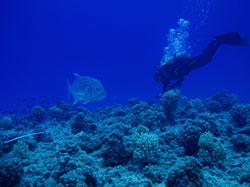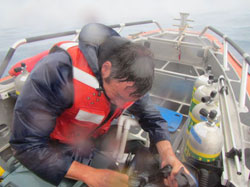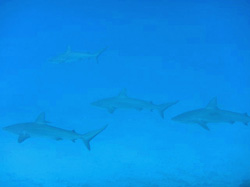
Reef Assessment and Monitoring Program Expediton Log – August 12, 2012
A is for Apex Predator!
By: Megan Onuma & Carlie Wiener, COSEE Island Earth

Scientists working hard to assess the health of coral reefs, while large fish like ulua look on. Credit: J. Burns
We have now been at Pearl and Hermes Atoll for three days and today marks our final day of field operations at this location. The atoll is named after two English whaling ships, the Pearl and the Hermes that wrecked in the reefs of this electric blue lagoon in 1822. So far, the scientists have discovered that this atoll should be noted more for its large amount of apex predators (species at the top of the food chain like large fish and sharks). At many of the dive sites here at Pearl and Hermes, large ulua and gray reef sharks have been supervising most of the research.
Navigating the Northwestern Hawaiian Islands waters can be tricky with emergent reefs and high swells, and so far Pearl and Hermes has been fairly challenging due to dicey weather. Much skill and care goes into navigating the small boats around the atolls. Researchers and crew fight large waves to get their research done; yet, many times people do not picture this type of weather in remote reef areas near the equator. Cold field days, wind burn, and rain are all part of the package. Dedicated scientists are happy to brave the elements though, just to have the opportunity to characterize and monitor these remote reefs. Describing the dive experiences in these waters is difficult to put into words, but the amazement that is held after seeing soaring brown boobies above the boat, and flying-fish grazing the oceans surfaces is out of control amazing.
Going out with the "coral crew", we were able to witness curious marine species checking out the SCUBA divers as they went about their work. Within minutes of entry into the water, inquisitive fish began to arrive. The Giant Trevally (ulua), which can grow up to four or five feet long, seemed to be attracted to the researchers. On this particular dive, the ulua came in schools of up to ten. The huge, silvery fish wove in and out among the scientists as they set their transect lines and began recording the coral species along the bottom. The ulua were clearly as inquisitive about us, as we were about them.
With the influx of ulua, several sharks came along as well; at the peak we counted thirteen sharks. The ulua and sharks had no obvious fear of us or of each other, gliding gracefully about the reefs. Seeing this many large fish is really unique, as sharks and ulua are often not seen in large numbers in the main Hawaiian Islands anymore. This can be attributed to human impacts such as overfishing. In fact, if you added up all the "apex predators" in the main Hawaiian Islands and compared them to the other marine species they would total about 3% of the biomass (amount of living matter in a volume of habitat); this is fairly low compared to the 54% biomass found in the Northwestern Hawaiian Islands.
Being surrounded by these species poses no threat to the divers who always execute their work with caution and respect for the surrounding marine life. So far, dive operations at Pearl and Hermes have been extremely successful with scientists able to get all their intended surveys of the reefs completed, and have retrieved all instrumentation and acoustic monitoring tools placed in the water either last year or earlier in the trip.
Click here to go back to the Expedition Log.


